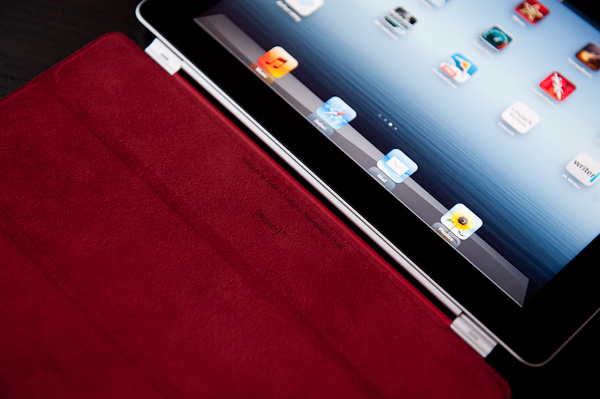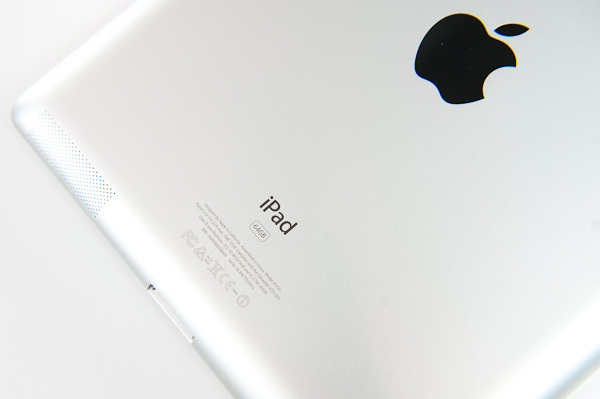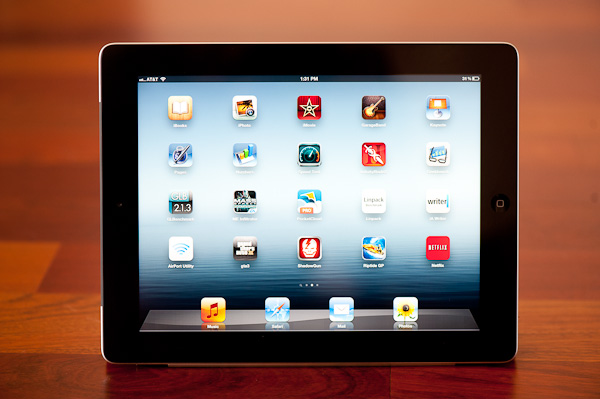The Apple iPad Review (2012)
by Vivek Gowri & Anand Lal Shimpi on March 28, 2012 3:14 PM ESTFinal Words
The new iPad represented Apple’s largest tablet launch yet, and according to their sales figures, three million units were moved over the opening weekend. That’s nearly $2 billion in tablets...in three days. Hotcakes are selling like iPads these days.
The new iPad is externally very similar to the iPad 2, but my feeling is that there's a much larger step in usability from the iPad 2 to the new iPad than there was from the original to the iPad 2. It's a difference that has nothing to do with form factor and everything to do with the Retina Display. The iPad 2 took the original iPad and made it better or more refined in every way—thinner, lighter, faster—but the experience didn't change radically. The Retina Display represents a fundamental change in how you visually interact with the device. The display is really the center of a tablet's experience, and with a display that drastically improved, the experience is correspondingly better.
It really is something that you notice in every single way you use the tablet. Text, whether you're reading it or writing it, is rendered far more accurately. High resolution graphics look fantastic, and UI elements look sharp in a way that the iPad 2 simply cannot match. Compared to the original iPad, the difference is stark, and it’s impossible to emphasize how huge a step up from the original 9.7" XGA display the Retina Display really is. It's a bit like the jump from SD to HD television, or from DVD to Bluray. Functionally, it's not terribly different, but it's a fundamental leap in technology. And once you take that leap, it's difficult to go back.
If you pay for and frequently use a cellular data plan on your iPad, the new iPad is worth the upgrade for LTE alone. LTE is very impressive on a smartphone but you're limited by how much downloading/browsing/multitasking you're willing to do on a very small screen. On a tablet, you're much more likely to treat the device like an ultraportable notebook, in which case an LTE iPad has a huge advantage over most WiFi-only ultraportables. LTE on the iPad is just like having awesome WiFi wherever you go. It's great.
I prefaced all of this with a question about your willingness to pay for the data plan, because even though you're not bound by any sort of a contract, the cost per GB transferred over LTE on both AT&T and Verizon is just unreasonable. If these carriers don't raise their data limits soon, they'll be directly responsible for stifling the growth of the mobile market. Can you imagine what the Internet revolution would've been like had we remained on hourly billing for cable/DSL?
Apple continues to push the envelope on the SoC side as well. Shipping a 163mm2 SoC on a 45nm LP process is something I never expected Apple to do, but it's here and will hopefully encourage other, actual SoC vendors to start behaving like good chip design companies and not like commodity peddlers. We need faster CPUs and GPUs in a major way; Apple can't be the only company aggressively pursuing these needs if others want to be successful. No one ever won by being the slowest on the block.
With all of this said—should you buy the new iPad?
If you are an existing iPad owner, the question is whether or not you should upgrade. If you don't use your iPad all that much, the upgrade obviously isn't worth it. Even if you do use your iPad a lot, unless you're going to use LTE, there isn't a functional or performance advantage to the new iPad. As is always the case, if you can hold off there's always something better around the corner. In this case, next-year's model should bring with it better performance and an increase in power efficiency thanks to 28/32nm silicon. There the decision really boils down to how much you'd appreciate the Retina Display—and as we already mentioned, there's a lot to appreciate.
If you have an iPad 2 you actually end up making a bit of a battery life and portability trade off if you choose the new iPad. It's still not as bulky as a MacBook Air (which already isn't bulky) but it's noticeably heavier than the iPad 2. The new iPad is nicer to use, but it's not as nice to carry. If you're still on the original iPad and use it frequently, the upgrade is a no brainer—you get a faster platform, a lighter chassis, better display and better cellular connectivity (optional).
If you're not a tablet owner, are in desperate need of one, and are looking to buy one now—the new iPad is as good as it gets today. This is Apple's halo iDevice. It has the fastest and best of nearly every component inside and out. It's got everything but the kitchen sink. As long as you're ok with iOS, there's no reason not to get the new iPad.













234 Comments
View All Comments
name99 - Friday, March 30, 2012 - link
Just to clarify, this is NOT some Apple proprietary thing. The Apple ports are following the USB charging spec. This is an optional part of the spec, but any other manufacturer is also welcome to follow it --- if they care about the user experience.darkcrayon - Thursday, March 29, 2012 - link
All recent Macs (last 2-3 years) can supply additional power via their USB ports which is enough to charge an iPad that's turned on (though probably not if it's working very hard doing something). Most non-Mac computer USB ports can only deliver the standard amount of USB power, which is why you're seeing this.Your Lenovo *should* still recharge the iPad if the iPad is locked and sleeping, though it will do so very slowly.
dagamer34 - Friday, March 30, 2012 - link
I did the calculations and it would take about 21 hours to recharge an iPad 3 on a normal non-fast charging USB port from dead to 100%. Keep in mind, we're talking about a battery that's larger in capacity than the 11" MacBook Air.snoozemode - Thursday, March 29, 2012 - link
http://www.qualcomm.com/media/documents/files/snap...Aenean144 - Thursday, March 29, 2012 - link
Anandtech: "iPhoto is a very tangible example of where Apple could have benefitted from having four CPU cores on A5X"Is iPhoto really a kind of app that can actually take advantage of 2 cores? If there are batch image processing type functionality, certainly, though I don't know if iPhoto for iOS has this type of functionality. The slowness could just be from a 1.0 product and further tuning and refinement will fix it.
I'm typically highly skeptical of the generic "if the app is multithreaded, it can make use of all of the cores" line of thought. Basically all of the threads, save one, are typically just waiting on user input.
Anand Lal Shimpi - Thursday, March 29, 2012 - link
It very well could be that iOS iPhoto isn't well written, but in using the editing tools I can typically use 60 - 95% of the A5X's two hardware threads. Two more cores, at the bare minimum, would improve UI responsiveness as it gives the scheduler another, lightly scheduled core to target.Alternatively, a 50% increase in operating frequency and an improvement in IPC could result in the same net benefit.
Take care,
Anand
shompa - Friday, March 30, 2012 - link
*hint* Use top on a iOS/Android device and you will see 30-60 processes at all time. The single threaded, single program thinking is Windows specific and have been solved on Unix since late 1960. Todays Windows phones are all single threaded because windows kernel is not good at Multit hreding.With many processes running, it will always be beneficial to have additional cores. Apple have also solved it in OSX by adding Grand central dispatch in their development tools making multithreaded programs easy.
Iphoto for Ipad: Editing 3 million pixel will demand huge amount of CPU/GPU time + memory. Apple have so far been able to program elegant solutions around the limits of ARM CPUs by using NOVA SIMD extensions and GPU acceleration. An educated guess is that Iphoto is not fully optimized and will be at later time.
(the integrated approach gives Apple a huge advantage over Android since Apple can accelerate stuff with SIMDs. Google does not control the hardware and can therefore not optimize its code. That is one of the reasons why single core A4 was almost as fast as dual core Tegras. I was surpassed when Google managed to implement their own acceleration in Andriod 4.X. Instead of SIMD, Google uses GL, since all devices have graphics cards. This is the best feuture in Android 4.x.)
name99 - Thursday, March 29, 2012 - link
[/quote]Apple’s design lifespan directly correlates to the maturity of the product line as well as the competitiveness of the market the product is in.
[/quote]
I think this is completely the wrong way to look at it. Look across the entire Apple product line.
I'd say a better analysis of chassis is that when a product first comes out, Apple can't be sure how it will be used and perceived, so there is some experimentation with different designs. But as time goes by, the design becomes more and more perfected (yes yes, if you hate Apple we know your feelings about the use of this word) and so there's no need to change until something substantial drives a large change.
Look, for example, at the evolution of iMac from the Luxo Jr version to the white all-in-on-flatscreen, to the current aluminum-edged flatscreen which is largely unchanged for what, five or six years now. Likewise for the MacBook Pro.
Look at the MacBook Air. The first two revs showed the same experimentation, trying different curves and angles, but Apple (and I'd say customers) seems to feel that the current wedge shape is optimal --- a definite improvement on the previous MBA models, and without anything that obviously needs to be improved. (Perhaps the sharp edges could be rounded a little, and if someone could work out the mechanicals, perhaps the screen could tilt further back.)
And people accept and are comfortable with this --- in spite of "people buy Apple as a fashion statement idiocy". No-one will be at all upset if the Ivy League iMacs and MBAs and Mac Minis look like their predecessors (apart from minor changes like USB3 ports) --- in fact people expect it.
So for iPhone and iPad. Might Apple keep using the same iPhone4 chassis for the next two years, with only minor changes? Why not? There's no obvious improvement it needs.
(Except, maybe, a magnet on the side like iPad has, so you could slip a book-like case on it that covered the screen, and switched it on by opening the book.)
Likewise for iPad.
New must have features in phones/tablets (NFC? near-field charging? waterproof? built-in projector like Samsung Beam?) might change things. But absent those, really, the issue is not "Apple uses two year design cycles", it is "Apple perfects the design, then sticks with it".
mr_ripley - Thursday, March 29, 2012 - link
"In situations where a game is available in both the iOS app store as well as NVIDIA's Tegra Zone, NVIDIA generally delivers a comparable gaming experience to what you get on the iPad... The iPad's GPU performance advantage just isn't evident in those cases..."Would you expect it to be if all the games you compare have not been optimized for the new ipad yet? They run at great frame rates but suffer in visuals or are only available at ipad 2 resolutions. The tegra zone games are clearly optimized for Tegra while their iOS counterparts are not optimized for the A5x, so of course the GPU advantage is not evident.
This comparison does not seem fair unless there is a valid reason to believe that the tegra zone games cannot be further enhanced/optimized to take advantage of the new ipad hardware.
I suspect that the tegra zone games optimized for A5x will offer a tangibly superior performance and experience. And the fact that the real world performance suffers today does not mean we will not see it shortly.
Steelbom - Thursday, March 29, 2012 - link
Exactly this.